What Is the Function of Restriction Endonucleases in Bacteria
Coli bacteria have an enzymatic immune system that recognizes and destroys foreign DNA 3000 enzymes have been identified around 200 have unique properties many are purified and available commercially. Molecular scissors discovered in in bacteria E.

Solved Question 99 What Is The Function Of Restriction Chegg Com
Bacterial transformation selection.
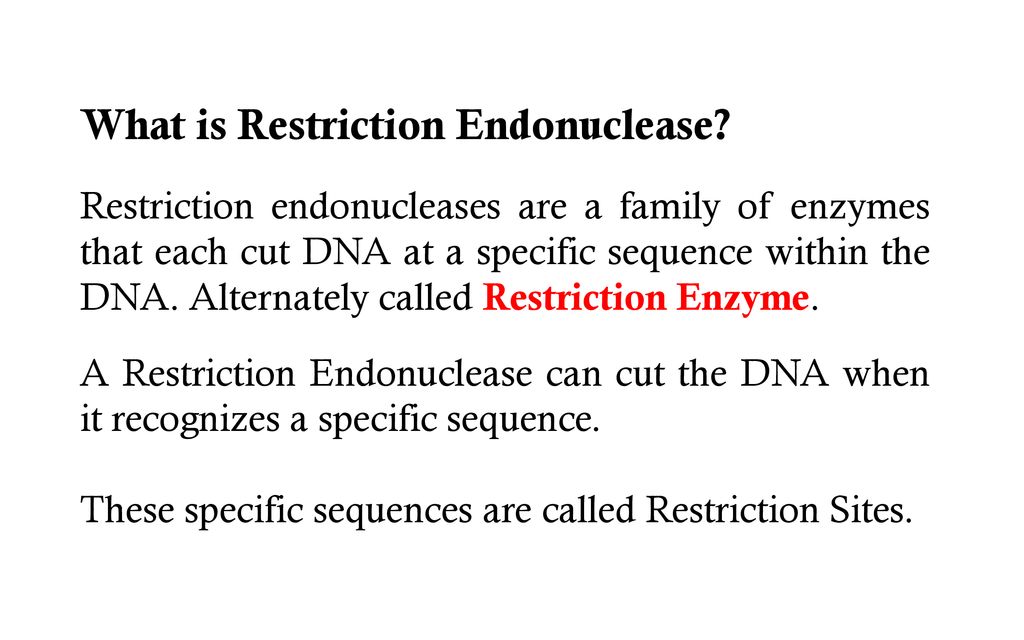
. Standard laboratory devices for making specific cuts in DNA as a first step in. Nomenclature for restriction enzymes is based on a convention using the first letter of the genus and the first two letters of the species name of the bacteria of origin. Sticky ends and blunt ends.
Methylation of DNA at the recognition. The restriction modification system is found in bacteria and other prokaryotic organisms and provides a defense against foreign DNA such as that borne by bacteriophages. Prokaryotes developed several strategies to evade viral attacks that include restriction modification abortive infection and CRISPRCas systems.
The difference between a restriction enzyme and any other endonucleases is that the restriction enzymes cleave at specific points known as restriction sites. The term restriction derives from the phenomenon in which bacterial viruses are restricted from replicating in certain strains of bacteria by enzymes that cleave the viral DNA but leave the bacterial DNA untouched. These enzymes can be purchased from the many manufacturers of biotechnology products.
If youre seeing this message it means were having trouble loading external resources on our website. For this reason they are indispensible tools of recombinant DNA technology genetic engineering. The ability to cleave DNA at specific sites is one of the cornerstones of todays methods of DNA manipulation.
Sticky ends and blunt ends. Restriction enzymes are commonly classified into five types which differ in their structure and whether. A bacterium uses a restriction enzyme to defend against bacterial viruses called bacteriophages or phages.
Restriction enzymes cut through both nucleotide strands breaking the DNA into fragments but they dont always do this in the same way. Restriction enzymes are Nucleases which can cleave the sugar-phosphate backbone of DNA found in bacteria. These adaptive immune systems found in many Bacteria and most Archaea consist of clustered regularly interspaced short palindromic repeat CRISPR sequences and a number of CRISPR associated Cas genes Fig.
BThey allow bacteria to genetically recombine with other bacteria. Cleavage yields random or specific double-stranded fragments with terminal 5-phosphates. Most have been studied in bacterial systems but a few have been found in eukaryotic organisms.
The restriction enzyme prevents replication of the phage DNA by cutting it into many pieces. These endonucleases have become standard laboratory devices for making specific cuts in DNA as a first step in deducing sequences and are sometimes referred to as a chemical knife usually. DThey provide a defense mechanism against infection by viruses.
It must be emphasized that the principal functions of restriction enzymes namely dimerization DNA binding and DNA cleavage are interwoven which means that regions involved in one function are often also of importance for another function see also Fig. Restriction endonucleases are bacterial enzymes that cleave duplex DNA at specific target sequences with the production of defined fragments. Bacteria protect their DNA by modifying their own recognition sequences usually by adding methyl CH 3 molecules to nucleotides in the recognition sequences and then relying on.
They can be isolated from the bacteria and used in the laboratories. Bacteria have restriction enzymes also called restriction endonucleases which cleave double stranded DNA at specific points into fragments which are then degraded further by other endonucleases. One of many endonucleases isolated from bacteria that cleave or hydrolyze cut foreign double-stranded DNA chains at specific recognition sites defined by DNA sequences.
They provide a defense mechanism against infection by DNA viruses They serve no function They allow bacteria to conjugate with other bacteria They facilitate genetic recombination between the bacterial chromosome They enable transfection of the bacterial. Rĕ-strikshŭn endō-nūklē-ās One of many endonucleases isolated from bacteria that hydrolyze cut double-stranded DNA chains at specific sequences thus inactivating a foreign viral or other DNA and restricting its activity. As they cut within the molecule they are commonly called restriction endonucleases.
Restriction enzymes can be isolated from bacterial cells and used in the laboratory to manipulate fragments of DNA such as those that contain genes. SmaI is an example of a restriction enzyme that cuts straight through the DNA strands creating DNA fragments with a flat or blunt end. To synthesize the DNA artificially.
C They allow bacteria to engineer new DNA fragments. Restriction Endonucleases Also called restriction enzymes 1962. Restriction enzymes are proteins that bind to DNA in a very specific manner.
A They serve no function. Restriction endonucleases are the class of nuclease enzymes that have the power to cut the DNA. When a phage infects a bacterium it inserts its DNA into the bacterial cell so that it might be replicated.
What is the function of restriction endonucleases in bacteria. Other restriction enzymes like EcoRI cut through the DNA strands at. Role of restriction endonuclease-This enzyme cuts the DNA very precisely and thus eliminates the infecting organisms-It cut double stranded DNA at specific recognition sites-This enzyme can recognise specific base sequences on DNA and then it cut each strand at the given place therefore restriction endonucleases are also called as Molecular Scissors.
In bacteria restriction enzymes form a system with modification enzymes that methylate the bacterial DNA. They recognize and cleave at the restriction sites of the bacteriophage and destroy its DNA. The function of restriction enzymes is to destroy any foreign DNA that invades the host cell.
So they actually recognize the base pairs within the DNA. The endonucleases are different from the exonucleases having a specialized function to cut DNA inside. They specifically cleave the nucleic acids at specific nucleotide sequence called Restriction sites to generate a set of smaller fragments.
This site is known as the restriction site. And typically they will bind to a palindromic sequence for instance a sequence that is a mirror copy of itself--AGCCGA. In the bacterial cell restriction enzymes cleave foreign DNA thus eliminating infecting organisms.
Restriction enzymes are important tools for genetic engineering. QUESTION 99 What is the function of restriction endonucleases in bacteria. Restriction enzymes are one class of the broader endonuclease group of enzymes.
A restriction enzyme restriction endonuclease or restrictase is an enzyme that cleaves DNA into fragments at or near specific recognition sites within molecules known as restriction sites. The restriction enzymes protect the live bacteria from bacteriophages. A restriction enzyme is an enzyme produced by certain bacteria which helps in the cutting or cleaving of the deoxyribonucleic acid DNA into smaller parts or fragments in any molecule.
These enzymes naturally occur in thousands of bacterial strains and presumably function as the cells defense against bacterio-phage DNA. To cut the DNA at a specific location.

Restriction Endonucleases A Are Found In Bacteria B Are Very Useful In Genetic Engineering C Cut The Dna At Particular Sites D Are Used Naturally In A Bacterial Cell To Defend Against
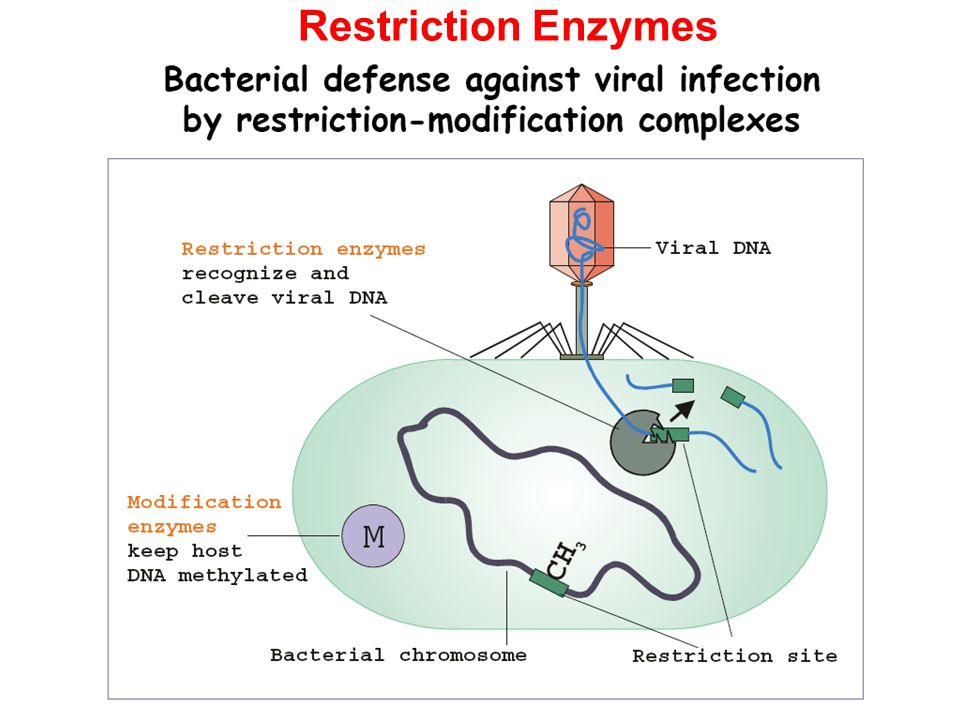
Restriction Enzymes Ppt Video Online Download
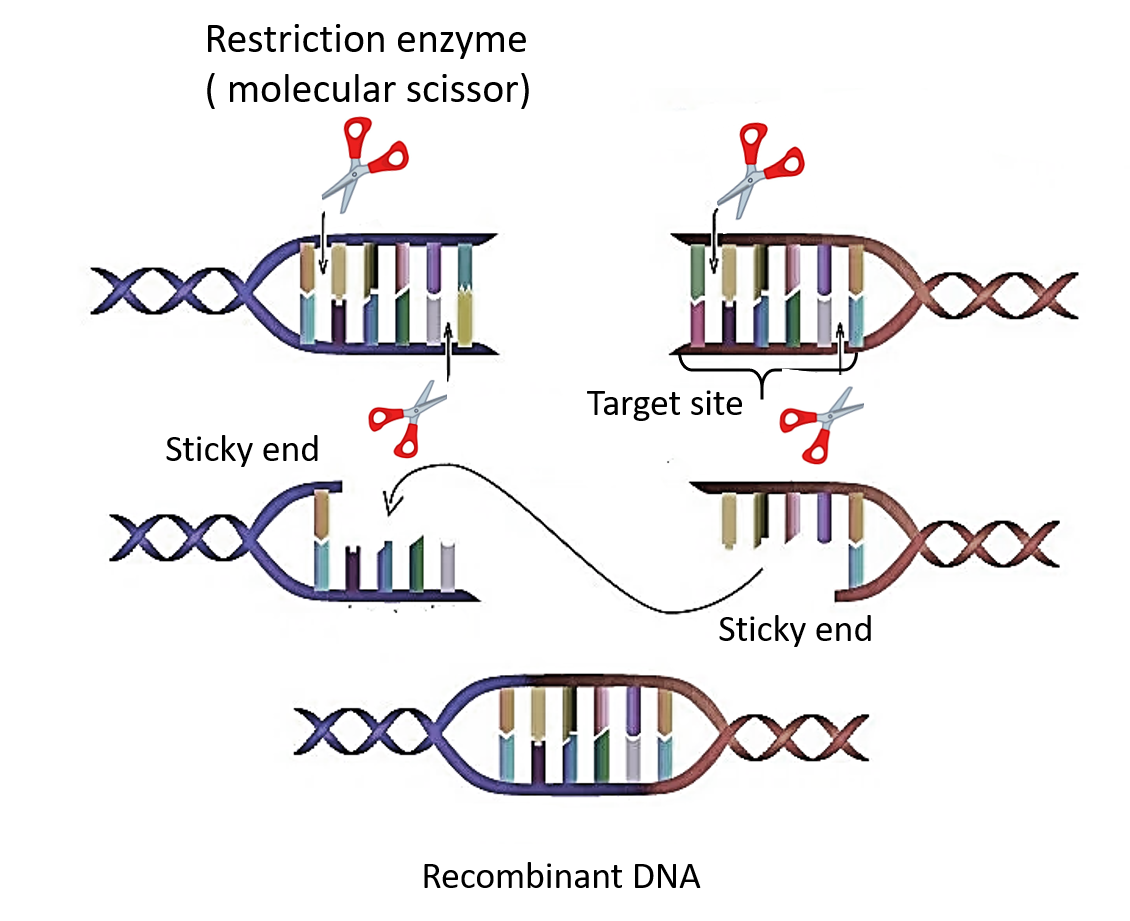
The Normal Function For Restriction Endonuclease Is Class 12 Biology Cbse

Restriction Enzymes The Definitive Guide Biology Dictionary
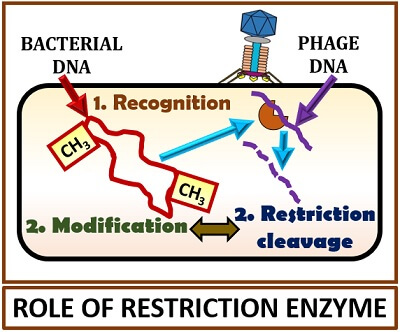
What Is Restriction Enzyme Definition Role Nomenclature Types Working Biology Reader

Restriction Endonuclease Ppt Download

What Is The Difference Between Restriction Enzymes Type 1 2 And 3 Pediaa Com
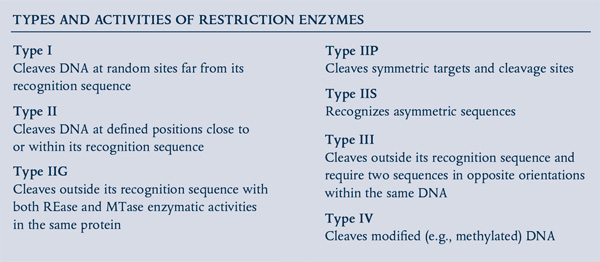
Restriction Endonucleases Molecular Cloning And Beyond Neb

Restriction Enzymes Function Purpose What Are Restriction Enzymes Video Lesson Transcript Study Com

Restriction Enzymes Types Examples Studiousguy

Learn About Restriction Endonucleases In Dna Cloning Chegg Com

Restriction Enzymes Powerpoint Slides
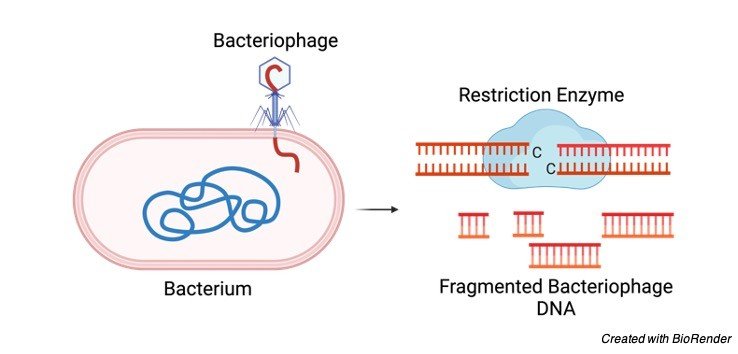
Restriction Enzyme Definition Function And Types
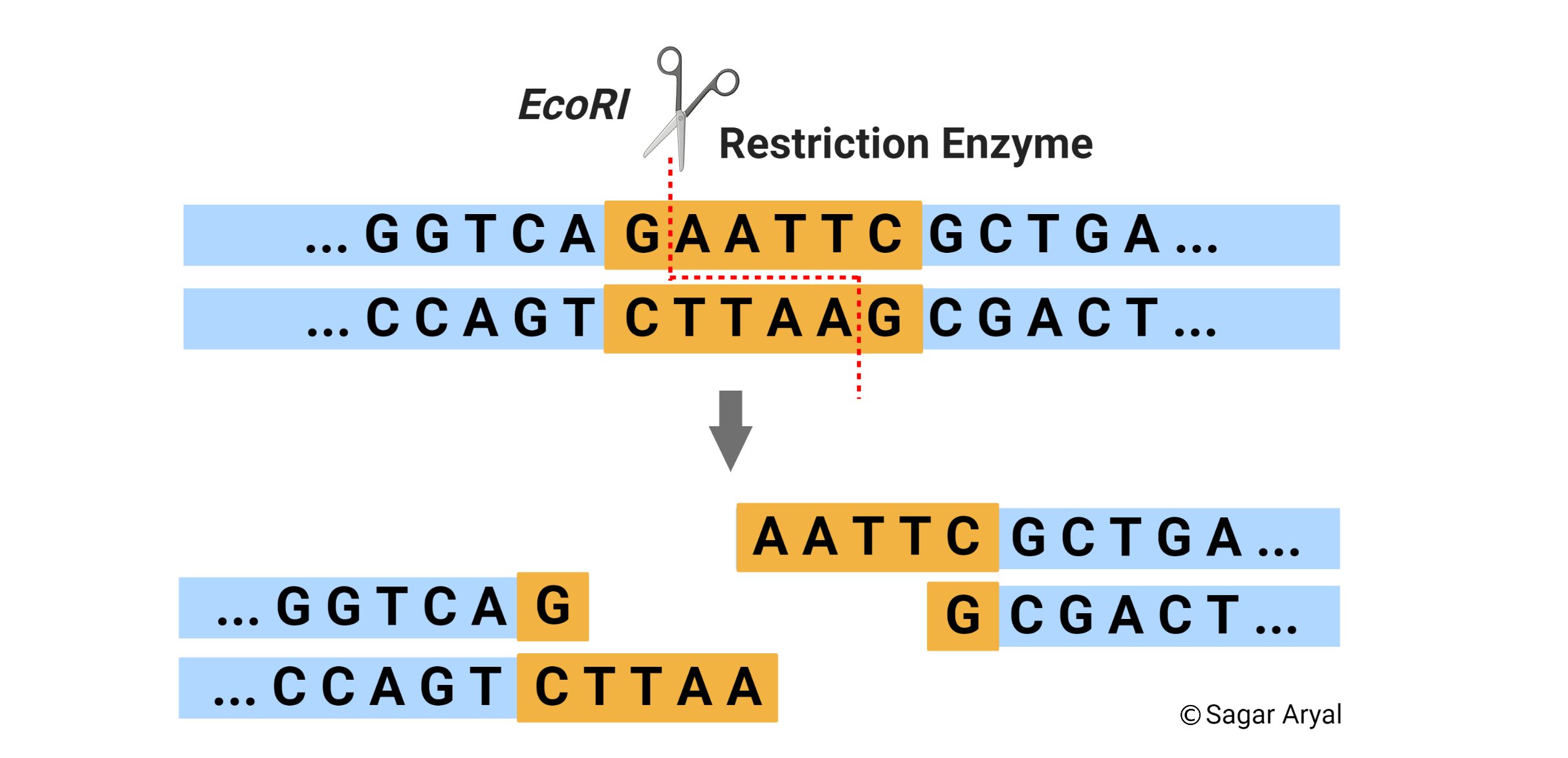
Restriction Enzyme Restriction Endonuclease

Restriction Enzymes The Definitive Guide Biology Dictionary
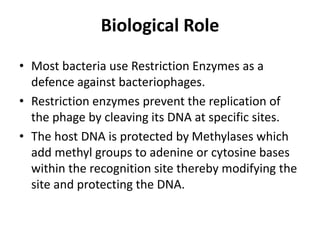



Comments
Post a Comment